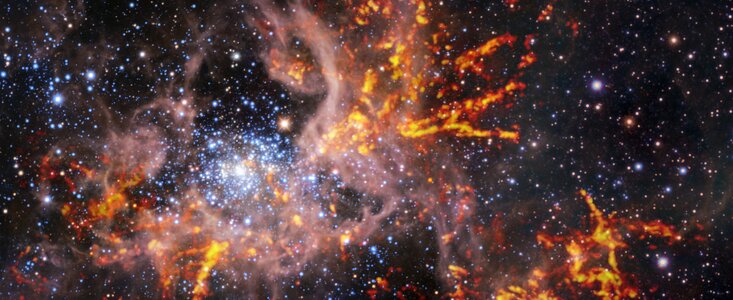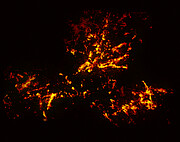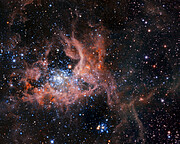Press Release
The Tarantula's cosmic web: astronomers map violent star formation in nebula outside our galaxy
15 June 2022

Astronomers have unveiled intricate details of the star-forming region 30 Doradus, also known as the Tarantula Nebula, using new observations from the Atacama Large Millimeter/submillimeter Array (ALMA). In a high-resolution image released today by the European Southern Observatory (ESO) and including ALMA data, we see the nebula in a new light, with wispy gas clouds that provide insight into how massive stars shape this region.
“These fragments may be the remains of once-larger clouds that have been shredded by the enormous energy being released by young and massive stars, a process dubbed feedback,” says Tony Wong, who led the research on 30 Doradus presented today at the American Astronomical Society (AAS) meeting and published in The Astrophysical Journal. Astronomers originally thought the gas in these areas would be too sparse and too overwhelmed by this turbulent feedback for gravity to pull it together to form new stars. But the new data also reveal much denser filaments where gravity’s role is still significant. “Our results imply that even in the presence of very strong feedback, gravity can exert a strong influence and lead to a continuation of star formation,” adds Wong, who is a professor at the University of Illinois at Urbana-Champaign, USA.
Located in the Large Magellanic Cloud, a satellite galaxy of our own Milky Way, the Tarantula Nebula is one of the brightest and most active star-forming regions in our galactic neighbourhood, lying about 170 000 light-years away from Earth. At its heart are some of the most massive stars known, a few with more than 150 times the mass of our Sun, making the region perfect for studying how gas clouds collapse under gravity to form new stars.
"What makes 30 Doradus unique is that it is close enough for us to study in detail how stars are forming, and yet its properties are similar to those found in very distant galaxies, when the Universe was young,” said Guido De Marchi, a scientist at the European Space Agency (ESA) and a co-author of the paper presenting the new research. “Thanks to 30 Doradus, we can study how stars used to form 10 billion years ago when most stars were born."
While most of the previous studies of the Tarantula Nebula have focused on its centre, astronomers have long known that massive star formation is happening elsewhere too. To better understand this process, the team conducted high-resolution observations covering a large region of the nebula. Using ALMA, they measured the emission of light from carbon monoxide gas. This allowed them to map the large, cold gas clouds in the nebula that collapse to give birth to new stars — and how they change as huge amounts of energy are released by those young stars.
“We were expecting to find that parts of the cloud closest to the young massive stars would show the clearest signs of gravity being overwhelmed by feedback,” says Wong. “We found instead that gravity is still important in these feedback-exposed regions — at least for parts of the cloud that are sufficiently dense.”
In the image released today by ESO, we see the new ALMA data overlaid on a previous infrared image of the same region that shows bright stars and light pinkish clouds of hot gas, taken with ESO’s Very Large Telescope (VLT) and ESO’s Visible and Infrared Survey Telescope for Astronomy (VISTA). The composition shows the distinct, web-like shape of the Tarantula Nebula’s gas clouds that gave rise to its spidery name. The new ALMA data comprise the bright red-yellow streaks in the image: very cold and dense gas that could one day collapse and form stars.
The new research contains detailed clues about how gravity behaves in the Tarantula Nebula’s star-forming regions, but the work is far from finished. “There is still much more to do with this fantastic data set, and we are releasing it publicly to encourage other researchers to conduct new investigations,” Wong concludes.
More information
This research is being presented at the 240th meeting of the American Astronomical Society (AAS) in the press conference titled "Stars, Their Environments & Their Planets” (Wednesday, 15 June, 19:15 CEST / 10:15 PT). Reporters are welcome to watch the live stream of the press conference, which will be visible publicly on the AAS Press Office YouTube channel: https://www.youtube.com/c/AASPressOffice.
The research is also presented in the paper “The 30 Doradus Molecular Cloud at 0.4 Parsec Resolution with ALMA: Physical Properties and the Boundedness of CO Emitting Structures” (https://iopscience.iop.org/article/10.3847/1538-4357/ac723a
) to appear in The Astrophysical Journal.
The team is composed of T. Wong (Astronomy Department, University of Illinois, USA [Illinois]), L. Oudshoorn (Leiden Observatory, Leiden University, The Netherlands [Leiden]), E. Sofovich (Illinois), A. Green (Illinois), C. Shah (Illinois), R. Indebetouw (Department of Astronomy, University of Virginia, USA and National Radio Astronomy Observatory, USA [NRAO]), M. Meixner (SOFIA-USRA, NASA Ames Research Center, USA), A. Hacar (Department of Astrophysics, University of Vienna, Austria), O. Nayak (Space Telescope Science Institute, USA [STSci]), K. Tokuda (Department of Earth and Planetary Sciences, Faculty of Sciences, Kyushu University, Japan and National Astronomical Observatory of Japan, National Institutes of Natural Sciences, Japan and Department of Physics, Graduate School of Science, Osaka Metropolitan University, Japan [Osaka]), A. D. Bolatto (Department of Astronomy and Joint Space Science Institute, University of Maryland, USA and NRAO Visiting Astronomer), M. Chevance (Astronomisches Rechen-Institut, Zentrum für Astronomie der Universität Heidelberg, Germany), G. De Marchi (European Space Research and Technology Centre, Netherlands), Y. Fukui (Department of Physics, Nagoya University, Japan), A. S. Hirschauer (STSci), K. E. Jameson (CSIRO, Space and Astronomy, Australia), V. Kalari (International Gemini Observatory, NSF’s NOIRLab, Chile), V. Lebouteiller (AIM, CEA, CNRS, Université Paris-Saclay, Université Paris Diderot, France), L. W. Looney (Illinois), S. C. Madden (Departement d’Astrophysique AIM/CEA Saclay, France), Toshikazu Onishi (Osaka), J. Roman-Duval (STSci), M. Rubio (Departamento de Astronomía, Universidad de Chile, Chile) and A. G. G. M. Tielens (Department of Astronomy, University of Maryland, USA and Leiden).
The European Southern Observatory (ESO) enables scientists worldwide to discover the secrets of the Universe for the benefit of all. We design, build and operate world-class observatories on the ground — which astronomers use to tackle exciting questions and spread the fascination of astronomy — and promote international collaboration in astronomy. Established as an intergovernmental organisation in 1962, today ESO is supported by 16 Member States (Austria, Belgium, Czechia, Denmark, France, Finland, Germany, Ireland, Italy, the Netherlands, Poland, Portugal, Spain, Sweden, Switzerland and the United Kingdom), along with the host state of Chile and with Australia as a Strategic Partner. ESO’s headquarters and its visitor centre and planetarium, the ESO Supernova, are located close to Munich in Germany, while the Chilean Atacama Desert, a marvellous place with unique conditions to observe the sky, hosts our telescopes. ESO operates three observing sites: La Silla, Paranal and Chajnantor. At Paranal, ESO operates the Very Large Telescope and its Very Large Telescope Interferometer, as well as two survey telescopes, VISTA working in the infrared and the visible-light VLT Survey Telescope. Also at Paranal ESO will host and operate the Cherenkov Telescope Array South, the world’s largest and most sensitive gamma-ray observatory. Together with international partners, ESO operates APEX and ALMA on Chajnantor, two facilities that observe the skies in the millimetre and submillimetre range. At Cerro Armazones, near Paranal, we are building “the world’s biggest eye on the sky” — ESO’s Extremely Large Telescope. From our offices in Santiago, Chile we support our operations in the country and engage with Chilean partners and society.
The Atacama Large Millimeter/submillimeter Array (ALMA), an international astronomy facility, is a partnership of ESO, the U.S. National Science Foundation (NSF) and the National Institutes of Natural Sciences (NINS) of Japan in cooperation with the Republic of Chile. ALMA is funded by ESO on behalf of its Member States, by NSF in cooperation with the National Research Council of Canada (NRC) and the Ministry of Science and Technology (MOST) and by NINS in cooperation with the Academia Sinica (AS) in Taiwan and the Korea Astronomy and Space Science Institute (KASI). ALMA construction and operations are led by ESO on behalf of its Member States; by the National Radio Astronomy Observatory (NRAO), managed by Associated Universities, Inc. (AUI), on behalf of North America; and by the National Astronomical Observatory of Japan (NAOJ) on behalf of East Asia. The Joint ALMA Observatory (JAO) provides the unified leadership and management of the construction, commissioning and operation of ALMA.
Links
- Research paper
- NRAO press release
- Photos of ALMA
- Photos of VISTA
- Photos of the VLT
- Other images of the Tarantula Nebula region
- For journalists: subscribe to receive our releases under embargo in your language
- For scientists: got a story? Pitch your research
Contacts
Tony Wong
Astronomy Department, University of Illinois
Urbana-Champaign, IL, USA
Tel: +1 217 244 4207
Email: wongt@illinois.edu
Guido De Marchi
European Space Research and Technology Centre, European Space Agency
Noordwijk, Netherlands
Tel: +31 71 565 8332
Cell: +31 6 5081 6906
Email: gdemarchi@esa.int
Bárbara Ferreira
ESO Media Manager
Garching bei München, Germany
Tel: +49 89 3200 6670
Cell: +49 151 241 664 00
Email: press@eso.org
About the Release
| Release No.: | eso2209 |
| Name: | 30 Doradus, Tarantula Nebula |
| Type: | Local Universe : Nebula : Type : Star Formation |
| Facility: | Atacama Large Millimeter/submillimeter Array |
| Science data: | 2022ApJ...932...47W |
Our use of Cookies
We use cookies that are essential for accessing our websites and using our services. We also use cookies to analyse, measure and improve our websites’ performance, to enable content sharing via social media and to display media content hosted on third-party platforms.
ESO Cookies Policy
The European Organisation for Astronomical Research in the Southern Hemisphere (ESO) is the pre-eminent intergovernmental science and technology organisation in astronomy. It carries out an ambitious programme focused on the design, construction and operation of powerful ground-based observing facilities for astronomy.
This Cookies Policy is intended to provide clarity by outlining the cookies used on the ESO public websites, their functions, the options you have for controlling them, and the ways you can contact us for additional details.
What are cookies?
Cookies are small pieces of data stored on your device by websites you visit. They serve various purposes, such as remembering login credentials and preferences and enhance your browsing experience.
Categories of cookies we use
Essential cookies (always active): These cookies are strictly necessary for the proper functioning of our website. Without these cookies, the website cannot operate correctly, and certain services, such as logging in or accessing secure areas, may not be available; because they are essential for the website’s operation, they cannot be disabled.
Functional Cookies: These cookies enhance your browsing experience by enabling additional features and personalization, such as remembering your preferences and settings. While not strictly necessary for the website to function, they improve usability and convenience; these cookies are only placed if you provide your consent.
Analytics cookies: These cookies collect information about how visitors interact with our website, such as which pages are visited most often and how users navigate the site. This data helps us improve website performance, optimize content, and enhance the user experience; these cookies are only placed if you provide your consent. We use the following analytics cookies.
Matomo Cookies:
This website uses Matomo (formerly Piwik), an open source software which enables the statistical analysis of website visits. Matomo uses cookies (text files) which are saved on your computer and which allow us to analyze how you use our website. The website user information generated by the cookies will only be saved on the servers of our IT Department. We use this information to analyze www.eso.org visits and to prepare reports on website activities. These data will not be disclosed to third parties.
On behalf of ESO, Matomo will use this information for the purpose of evaluating your use of the website, compiling reports on website activity and providing other services relating to website activity and internet usage.
Matomo cookies settings:
Additional Third-party cookies on ESO websites: some of our pages display content from external providers, e.g. YouTube.
Such third-party services are outside of ESO control and may, at any time, change their terms of service, use of cookies, etc.
YouTube: Some videos on the ESO website are embedded from ESO’s official YouTube channel. We have enabled YouTube’s privacy-enhanced mode, meaning that no cookies are set unless the user actively clicks on the video to play it. Additionally, in this mode, YouTube does not store any personally identifiable cookie data for embedded video playbacks. For more details, please refer to YouTube’s embedding videos information page.
Cookies can also be classified based on the following elements.
Regarding the domain, there are:
- First-party cookies, set by the website you are currently visiting. They are stored by the same domain that you are browsing and are used to enhance your experience on that site;
- Third-party cookies, set by a domain other than the one you are currently visiting.
As for their duration, cookies can be:
- Browser-session cookies, which are deleted when the user closes the browser;
- Stored cookies, which stay on the user's device for a predetermined period of time.
How to manage cookies
Cookie settings: You can modify your cookie choices for the ESO webpages at any time by clicking on the link Cookie settings at the bottom of any page.
In your browser: If you wish to delete cookies or instruct your browser to delete or block cookies by default, please visit the help pages of your browser:
Please be aware that if you delete or decline cookies, certain functionalities of our website may be not be available and your browsing experience may be affected.
You can set most browsers to prevent any cookies being placed on your device, but you may then have to manually adjust some preferences every time you visit a site/page. And some services and functionalities may not work properly at all (e.g. profile logging-in, shop check out).
Updates to the ESO Cookies Policy
The ESO Cookies Policy may be subject to future updates, which will be made available on this page.
Additional information
For any queries related to cookies, please contact: pdprATesoDOTorg.
As ESO public webpages are managed by our Department of Communication, your questions will be dealt with the support of the said Department.





